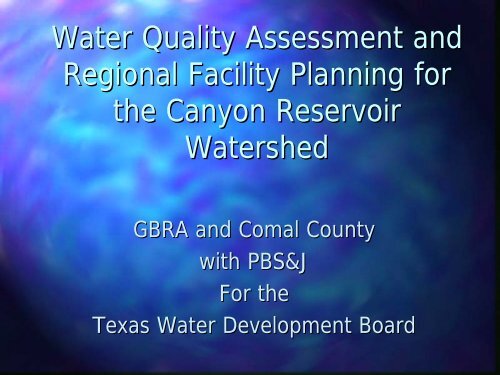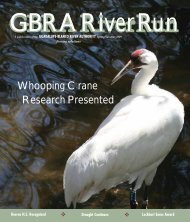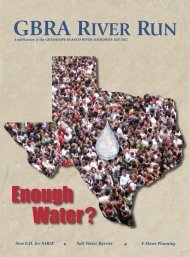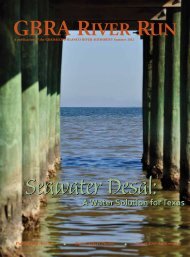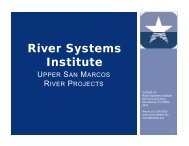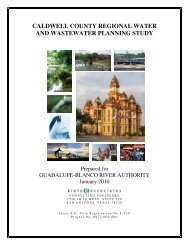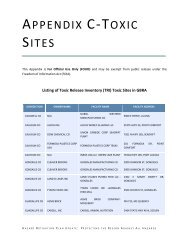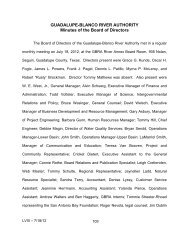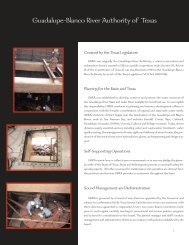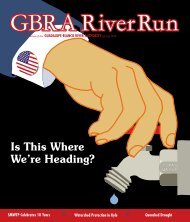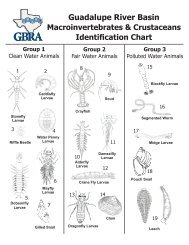Presentation given by Paul Jensen, PBS&J on the Canyon Water ...
Presentation given by Paul Jensen, PBS&J on the Canyon Water ...
Presentation given by Paul Jensen, PBS&J on the Canyon Water ...
Create successful ePaper yourself
Turn your PDF publications into a flip-book with our unique Google optimized e-Paper software.
<strong>Water</strong> Quality Assessment and<br />
Regi<strong>on</strong>al Facility Planning for<br />
<strong>the</strong> Cany<strong>on</strong> Reservoir<br />
<strong>Water</strong>shed<br />
GBRA and Comal County<br />
with PBS&J<br />
For <strong>the</strong><br />
Texas <strong>Water</strong> Development Board
STUDY BACKGROUND<br />
• Cany<strong>on</strong> Reservoir is <strong>the</strong> major water<br />
resource in <strong>the</strong> basin and has excellent<br />
water quality<br />
• In <strong>the</strong> past decade populati<strong>on</strong> growth in<br />
<strong>the</strong> immediate watershed has been<br />
rapid, and similar growth is expected<br />
• C<strong>on</strong>cern that water quality could be<br />
impacted was basis for study
BACKGROUND CONTINUED<br />
• There is good water quality today, with<br />
no indicati<strong>on</strong> of a recent decline<br />
• Despite recent populati<strong>on</strong> growth, <strong>the</strong>re<br />
appear to be few indicati<strong>on</strong>s of<br />
problems with existing septic systems<br />
• Accordingly, study focused <strong>on</strong> avoiding<br />
future problems ra<strong>the</strong>r than fixing<br />
present problems
Cany<strong>on</strong> <strong>Water</strong> Quality Data<br />
1981-1992 1993-2002<br />
TN (mg/L) 220 263<br />
TKN (mg/L) 296 244<br />
TP (mg/L) 53 50<br />
Chl a (mg/L) 3.4 2.0<br />
TSS (mg/L) 5.7 4.1<br />
Secchi Depth (m) 2.3 2.3
POPULATION PROJECTIONS<br />
• Texas State Data Center projecti<strong>on</strong>s<br />
employed<br />
• High growth scenario used to insure<br />
that study projecti<strong>on</strong>s would be<br />
c<strong>on</strong>servative
NUTRIENT LOADS CONSIDERED<br />
• Upstream loads from River<br />
• Point source discharges to reservoir<br />
• OSSF loads in study area<br />
• Runoff loads in study area
UPSTREAM LOADS<br />
• Data from Spring Branch gage analyzed<br />
• Average TSS, TN and TP loads/acre<br />
computed<br />
• These loads applied to study area as a<br />
start<br />
• Used to calibrate runoff calculati<strong>on</strong>s
RUNOFF LOADS<br />
• Calculated using procedures developed<br />
from City of Austin data<br />
• Adjusted to Spring Branch rate in 2000<br />
• Method quantifies effect of new<br />
development impervious cover and<br />
rapid drainage causing scour of<br />
tributary streams
PERCENTAGE LOAD REMOVAL<br />
BY CANYON RESERVOIR<br />
TSS<br />
TN<br />
TP<br />
All Data<br />
41<br />
38<br />
74<br />
Dry Year<br />
1996<br />
65<br />
64<br />
85<br />
Wet Year<br />
1997<br />
43<br />
87<br />
75
OSSF LOADS<br />
• Calculated from literature values<br />
• Assumed that all worked as intended<br />
• Used c<strong>on</strong>servative flow and<br />
c<strong>on</strong>centrati<strong>on</strong> values leaving septic tank<br />
• Assumed 90% removal of nutrients in<br />
drainfield
Projected TSS Load Changes<br />
to Cany<strong>on</strong> Lake<br />
Projected TSS Load Changes to Cany<strong>on</strong> Lake<br />
6,000,000<br />
5,000,000<br />
4,000,000<br />
3,000,000<br />
2,000,000<br />
Upstream<br />
Study Area Runoff<br />
WWTP<br />
1,000,000<br />
-<br />
2000 2010 2020 2030 2040
Projected TN Load Changes to<br />
Cany<strong>on</strong> Lake<br />
Projected TN Load Changes to Cany<strong>on</strong> Lake<br />
250,000<br />
200,000<br />
150,000<br />
100,000<br />
50,000<br />
Upstream<br />
Study Area Runoff<br />
OSSF<br />
WWTP<br />
-<br />
2000 2010 2020 2030 2040
Projected TP Load Changes to<br />
Cany<strong>on</strong> Lake<br />
Projected TP Load Changes to Cany<strong>on</strong> Lake<br />
35,000<br />
30,000<br />
25,000<br />
20,000<br />
15,000<br />
10,000<br />
Upstream<br />
Study Area Runoff<br />
OSSF<br />
WWTP<br />
5,000<br />
-<br />
2000 2010 2020 2030 2040
Projected Load<br />
Figure 5-3<br />
Projected Runoff and Septic TSS, TN, and TP Loads<br />
as % of Existing Loads at Cany<strong>on</strong> Lake<br />
Projected Load as % of Existing Load<br />
60<br />
40<br />
20<br />
0<br />
T<br />
S<br />
S<br />
T<br />
N<br />
T<br />
P<br />
T<br />
S<br />
S<br />
T<br />
N<br />
T<br />
P<br />
T<br />
S<br />
S<br />
T<br />
N<br />
2000 2010 2020 2030 2040<br />
T<br />
P<br />
T<br />
S<br />
S<br />
T<br />
N<br />
T<br />
P<br />
T<br />
S<br />
S<br />
T<br />
N<br />
T<br />
P<br />
TSS<br />
TN Runoff<br />
TN Septic<br />
TP Runoff<br />
TP Septic
Development Scenarios<br />
• Path A - C<strong>on</strong>tinuati<strong>on</strong> of <strong>the</strong><br />
present path<br />
• Path B - Regi<strong>on</strong>al Plan to<br />
encourage central wastewater<br />
systems <strong>on</strong> smaller lots and<br />
incorporating Low Impact<br />
Development features.
Elements of Protecti<strong>on</strong> Plan<br />
• Wastewater Treatment<br />
– New WWTP<br />
– OSSFs<br />
• Runoff
Regi<strong>on</strong>al WWTPs<br />
• For smaller lot developments<br />
• Would be “zero discharge” facilities<br />
emphasizing beneficial reuse:<br />
– Irrigati<strong>on</strong> of parks, commercial properties and golf<br />
courses<br />
– Possible supply to homeowners for irrigati<strong>on</strong><br />
• Emphasize management <str<strong>on</strong>g>by</str<strong>on</strong>g> public entity<br />
• Majority Steering Committee support<br />
• Minority of Committee opposed
RUNOFF<br />
Low Impact Development<br />
• Minimize impervious areas<br />
• Disc<strong>on</strong>nect impervious area drainage<br />
• Rainwater harvesting<br />
• Bioretenti<strong>on</strong><br />
• P<strong>on</strong>d retenti<strong>on</strong> and irrigati<strong>on</strong> use
IMPLEMENTING LID<br />
• Goal of keeping post-development<br />
runoff <strong>the</strong> same as pre-development<br />
can be achieved in many ways<br />
• Recommend that developments above a<br />
minimum size be required to have a PE<br />
certify that runoff will be similar to pre-<br />
development c<strong>on</strong>diti<strong>on</strong>
QUANTIFYING EFFECTS OF<br />
PLAN<br />
• Existing flood c<strong>on</strong>trol ordinance will have<br />
some effect in reducing runoff<br />
• Not take effect until 2010 because of backlog<br />
of platted development<br />
• Because most new homes in subdivisi<strong>on</strong>s, LID<br />
applied to 75% of populati<strong>on</strong> growth<br />
• Central WWTPs assumed to be used in<br />
subbasin 9, with 1 and 10 also candidates
Load with Recommended Plan<br />
Figure 5-4<br />
Projected Runoff and Septic TSS, TN, and TP Loads<br />
as % of Existing Loads at Cany<strong>on</strong> Lake<br />
with Recommended Acti<strong>on</strong> Plan<br />
Projected Load as % of Existing Load<br />
60<br />
40<br />
20<br />
0<br />
T<br />
S<br />
S<br />
T<br />
N<br />
T<br />
P<br />
T<br />
S<br />
S<br />
T<br />
N<br />
T<br />
P<br />
T<br />
S<br />
S<br />
T<br />
N<br />
2000 2010 2020 2030 2040<br />
T<br />
P<br />
T<br />
S<br />
S<br />
T<br />
N<br />
T<br />
P<br />
T<br />
S<br />
S<br />
T<br />
N<br />
T<br />
P<br />
TSS<br />
TN Runoff<br />
TN Septic<br />
TP Runoff<br />
TP Septic
STUDY AREA TN LOAD CHANGES<br />
Load in Kg/Yr<br />
90,000<br />
80,000<br />
70,000<br />
60,000<br />
50,000<br />
40,000<br />
30,000<br />
20,000<br />
10,000<br />
0<br />
TN with No Acti<strong>on</strong> Taken<br />
TN with Recommended Acti<strong>on</strong> Plan<br />
2000 2010 2020 2030 2040
STUDY AREA TP LOAD CHANGES<br />
35,000<br />
30,000<br />
Load in Kg/Yr<br />
25,000<br />
20,000<br />
15,000<br />
10,000<br />
5,000<br />
0<br />
TP with No Acti<strong>on</strong> Taken<br />
TP with Recommended Acti<strong>on</strong> Plan<br />
2000 2010 2020 2030 2040
Recommendati<strong>on</strong>s<br />
• Low Impact Development<br />
• On-Site Sewage Facilities<br />
• Regi<strong>on</strong>al WWTPs<br />
• Envir<strong>on</strong>mental Educati<strong>on</strong><br />
• <strong>Water</strong> C<strong>on</strong>servati<strong>on</strong><br />
• <strong>Water</strong> Quality Protecti<strong>on</strong> Z<strong>on</strong>e
OSSF<br />
• Used for greater than 1 acre lots<br />
• Educate <strong>on</strong> proper maintenance<br />
• Document OSSF failure data
Envir<strong>on</strong>mental Educati<strong>on</strong><br />
• Materials <strong>on</strong> OSSF operati<strong>on</strong><br />
• LID c<strong>on</strong>cepts<br />
• Minimal use of fertilizers & pesticides
<strong>Water</strong> C<strong>on</strong>servati<strong>on</strong><br />
• Native vegetati<strong>on</strong><br />
• Rainwater harvesting
<strong>Water</strong> Quality Protecti<strong>on</strong> Z<strong>on</strong>e<br />
• Area where recommendati<strong>on</strong>s would be<br />
focused<br />
• Regulati<strong>on</strong>s could be enforced <str<strong>on</strong>g>by</str<strong>on</strong>g><br />
County<br />
• May require legislative acti<strong>on</strong> to<br />
establish and grant authority to County


